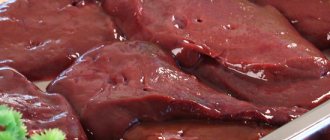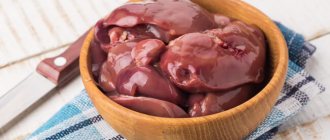Home / Gastroenterologist / Treatment of fatty hepatosis
Fatty hepatosis or fatty liver, fatty degeneration , is a reversible chronic process of hepatic degeneration that occurs as a result of excessive accumulation of lipids (fats) in liver cells.
The occurrence of fatty hepatosis directly depends on a person’s lifestyle, systematic eating disorders, and abuse of refined and fatty foods. The disease is reversible; with normalization of nutrition and loss of excess weight, the liver “loses weight” simultaneously with the entire body.
Stages of fatty hepatosis
There are 4 degrees of fatty hepatosis:
0 degree – separate groups of liver cells contain small particles of fat;
I degree – the size of fat droplets in the cells increases, separate foci of affected cells are formed (33% of affected hepatocytes in the field of view);
II degree – fat droplets of different sizes are contained in 33–66% of liver cells (small-droplet, medium-droplet, large-droplet intracellular obesity);
III degree - fat “extends” beyond the cells, extracellular fatty formations are formed - cysts (diffuse large-droplet obesity with extracellular localization) - more than 66% of affected hepatocytes in the field of view.
Causes of fatty hepatosis
The cause of fatty liver disease is metabolic syndrome - metabolic disorders and hormonal changes. In this case, diabetes mellitus and an increase in blood lipid levels develop with the threat of cardiovascular complications.
Fatty liver disease can be caused by:
- alcohol abuse,
- obesity,
- some viral infections (hepatitis B and C viruses),
- eating disorders,
- metabolic disorders in diabetes mellitus,
- increase in liver enzymes (ALT, AST, GGT),
- hereditary defects of the urea cycle and fatty acid oxidation,
- genetic factors
- certain medications, such as non-steroidal anti-inflammatory drugs.
Fatty liver: treatment
At the moment, there is no specific treatment for fatty liver . It consists of following a certain diet, exercise regimen, and treating an underlying or concomitant disease, for example, diabetes. If you suffer from alcohol addiction, then get rid of it by any means. If you are overweight, “lose” it, but not > 1 kg. in Week. Try to do without the use of medications, of course, if possible. Change your diet, limit your consumption of foods containing animal fats and carbohydrates, and increase your fiber intake. Include fresh fruits and vegetables in your daily menu, avoid all kinds of preservatives and consumption of “dead” food - various sausages. Attention! Of primary importance in the treatment of fatty liver is the restoration of the normal functionality of the immune system, because it is its failures that underlie the onset of any disease. Based on this, in the complex treatment of fatty liver, use Transfer Factor. It supports and strengthens the human immune system, subsequently preventing a “rollback” to previous positions after completion of therapy. The basis of this drug is made up of immune molecules of the same name, which, when entering the body: - eliminate failures of the endocrine and immune systems; - being information particles (of the same nature as DNA), transfer factors “record and store” all information about foreign agents - causative agents of various diseases that (agents) invade the body, and when they invade again, “transmit” this information to the immune system a system that neutralizes these antigens; — eliminate side effects that are caused by other medications. There is a whole line of this immunomodulator, of which Transfer Factor Advance and Transfer Factor Glucouch are used in the Endocrine System program for the prevention and complex treatment of endocrine and immune diseases and complications, including fatty liver.
Symptoms of fatty liver disease
Clinically, fatty liver hepatosis in the initial stages is characterized by an asymptomatic course, and severe fibrosis is manifested by characteristic signs of liver cirrhosis. Possible symptoms are discomfort in the right hypochondrium and hepatomegaly (enlarged liver).
Primary and 1st degree
One of the manifestations of fatty hepatosis can be a constantly fluctuating level of liver transaminases - the enzymes ALT and AST; they can increase in half of patients with signs of fatty hepatosis. As a result of fatty liver, a sluggish inflammatory process occurs, which leads to the development of either cirrhosis of the liver, or even its cancerous degeneration.
2nd degree
If symptoms increase, patients
- there is a feeling of heaviness in the right hypochondrium,
- discomfort in the abdomen, more on the right side,
- an enlarged liver may be detected with its edge protruding beyond the ribs by three to five centimeters,
- An ultrasound will show a liver that has changed in density with increased echogenicity.
- When conducting studies of blood vessels in the liver, it is clear that the blood flow in it is reduced.
Stage 3 fatty hepatosis
Gradually the disease progresses with the manifestation of symptoms such as
- constant nausea
- pain in the stomach and right side under the ribs, aching or dull, constant,
- distension in the right side,
- severe flatulence and constipation,
- disruption of food digestion.
Is it possible to cure non-alcoholic fatty liver disease completely?
Non-alcoholic fatty liver disease (non-alcoholic fatty liver disease, NAFLD) has several stages - non-alcoholic steatosis, non-alcoholic steatohepatitis, cirrhosis and liver cancer . The essence of this pathological condition is the excessive accumulation of fats (mainly triglycerides) in the liver tissue. The success of treatment of non-alcoholic fatty hepatosis depends on the stage of the disease, the general condition of the body and the presence of concomitant diseases.
How does fat get to the liver? Reasons for the development of non-alcoholic fatty hepatosis
The cause of the development of non-alcoholic fatty hepatosis is excess calories from food, not alcohol. Age, gender and genetics also contribute to an individual's risk of developing the disease. But the main risk factors are obesity, diabetes and metabolic disorders - high cholesterol and triglycerides in the blood. The likelihood of developing the disease increases with increasing body weight, and it is more common in men.
At the initial stages, with an increased intake of fats (lipids) from food, they accumulate in special cells of adipose tissue (adipocytes). When these cells are saturated, excess fat deposition begins in the cells of the liver, heart and other internal organs.
Liver cells (hepatocytes) can become oversaturated with fats coming either from the intestines, in case of excessive consumption of fatty foods, or from abdominal tissue, in case of abdominal obesity (“beer belly”). Thus, fatty hepatosis develops in the liver.
Why is diabetes and insulin resistance combined with non-alcoholic fatty liver disease?
In healthy people, insulin prevents fat cells (adipocytes) from breaking down and releasing fat. In people with insulin resistance, fat is released into the blood, where it is received by liver cells called hepatocytes.
Diagnosis of non-alcoholic fatty hepatosis
Since the disease is asymptomatic, and the success of treatment depends on the stage of liver damage it begins, timely diagnosis is very important.
To determine the stage of liver damage and associated fibrosis without the use of invasive liver biopsy, the following are used:
- biochemical blood tests (they show the degree of liver dysfunction);
- Ultrasound (allows you to detect early signs of diffuse changes in the liver and the deposition of excess fat);
- shear wave elastography of the liver (allows you to assess the stage of fibrosis).
To determine whether you are at risk for developing non-alcoholic fatty liver disease, you need to determine your body mass index. To calculate it, take your weight in kilograms and divide it by the square of your height in meters.
If your BMI is more than 25 kg/m2, sign up for an ultrasound and shear wave elastography of the liver at the Expert Gastroenterology Center by phone. 426-33-88.
Shear wave elastography of the liver is an accurate, painless method for diagnosing liver fibrosis.
Treatment of non-alcoholic fatty hepatosis
Treatment of non-alcoholic fatty hepatosis is a long and complex process that requires the active participation of the patient and the involvement of various specialists - a hepatologist, nutritionist, endocrinologist, cardiologist and therapist.
At the stage of non-alcoholic steatosis, all therapeutic measures are aimed at changing the patient’s lifestyle and usual physical activity.
Non-alcoholic liver steatosis
Normally, hepatocytes take up fats from the blood and include them in their metabolism. But when the relationship between the amount of fat penetrating into hepatocytes and the latter’s ability to utilize it is disrupted, small droplets of fat begin to settle in the cells. Initially, hepatocytes manage to actively process and remove excess fat. However, over time, they themselves “get fat”, accumulating fats, and the liver enzyme system becomes unable to metabolize their excess, i.e. liver steatosis develops.
All changes that occur in the liver at the stage of steatosis are completely reversible ; with successful treatment , the liver returns to a healthy state. But if, after recovery, a person returns to an unhealthy diet and gains excess weight again, non-alcoholic steatosis returns.
The main remedy is weight loss and physical activity.
How to lose weight correctly?
The cornerstone of treatment for non-alcoholic fatty liver disease is weight control through a combination of a healthy diet and sufficient exercise. Implementing diet and lifestyle changes is a very simple remedy, but can be difficult for many patients. Ideally, you should aim for a 10% reduction in body weight, but improvement may occur even if you reduce your weight by 3-5%. Weight loss surgery (bariatric surgery) may be an option for those who need significant weight loss if your BMI is over 40 kg/m2.
Measures for weight loss and prevention of complications
Reducing calories
To lose weight, you need to reduce the daily amount of calories you consume from food and increase your physical activity. Cutting calories is the key to losing weight and managing this disease. On average, reducing the caloric content of the daily diet by 500 - 1000 kcal will allow you to achieve a weight loss of 0.5 - 1 kg per week. For patients with non-alcoholic fatty liver disease, a diet rich in fruits (including their calorie content), vegetables and whole grains is recommended. For example, a Mediterranean-type diet with limited consumption of fatty “red” meat, simple carbohydrates and sugar. Also useful are foods containing increased amounts of omega-3 polyunsaturated fatty acids, plant fiber, and foods with a low glycemic index.
If you have already tried to lose weight and failed, we recommend that you consult a nutritionist.
You can make an appointment with a certified nutritionist at the Expert Gastroenterology Center by calling 426-33-88.
Physical activity
Exercise regularly, at least 30 minutes a day, every day. If you exercise regularly, increasing the number and duration of exercise will provide additional benefits. But if you haven't been exercising regularly, get your doctor's approval and start gradually.
Blood Sugar Control
Patients with diabetes, regardless of their weight, are already at risk for developing non-alcoholic fatty liver disease due to a tendency to accumulate fat in the liver, dyslipidemia and obesity. Stick to your diet and monitor your fasting blood glucose levels.
Reducing cholesterol levels
A slight decrease in body weight of only 5-10% helps reduce fat in the liver and normalize cholesterol metabolism. A healthy diet that is low in fat, moderate in carbohydrates and protein, as well as gradually increasing exercise and certain medications will help keep cholesterol and triglyceride levels within normal range.
Protect your liver
Avoid things that could put your liver under further stress. For example, don't drink alcohol. Follow instructions for all medications and supplements. Consult a hepatologist before using any medicinal herbs, as not all are safe for the liver.
You can make an appointment with a hepatologist to draw up an individual treatment program for non-alcoholic fatty hepatosis by calling 426-33-88.
Treatment of non-alcoholic fatty hepatosis at the Expert Gastroenterological Center. More details
Medicines for the treatment of non-alcoholic fatty liver disease
Drug therapy is aimed at reducing the degree of liver damage. It is usually prescribed at the stage of steatohepatitis or at high risk of developing liver fibrosis (age >50 years; diabetes mellitus, elevated liver enzymes, etc.).
Non-alcoholic steatohepatitis
Over time, in 30% of people, fat deposition in the liver can cause inflammation and the development of connective fibrous tissue - steatohepatitis, with the subsequent development of cirrhosis, liver failure and liver cancer in 15-20% of cases.
Non-alcoholic fatty liver disease (non-alcoholic fatty liver disease) at the stage of steatohepatitis is a potentially reversible condition; at this stage, doctors have enough resources to influence various parts of the disease, achieve stabilization of the process and improvement of liver enzymes and liver structure.
While there are currently no clinically tested or approved drugs to reduce liver fat, several drugs in research studies have shown good results. In addition, several options are under development for possible treatment strategies for non-alcoholic steatohepatitis, which today is considered a serious and dangerous disease. These are mainly drugs with anti-inflammatory and antifibrotic effects, as well as drugs that reduce insulin resistance.
Additional drugs used in the treatment of fatty liver disease
The treatment of non-alcoholic fatty liver disease uses medications that reduce the influence of risk factors and are additional to weight loss measures. Additional therapy is selected individually, taking into account the degree of liver damage and concomitant pathological conditions (metabolic syndrome, hypertension, insulin resistance, diabetes).
The goal of treatment with these drugs is
- correction of metabolic syndrome;
- treatment of hypertension;
- increasing tissue sensitivity to insulin;
- reducing cholesterol and triglyceride levels in the blood;
- reducing the degree of liver damage;
- normalization of intestinal flora in order to reduce the permeability of its walls.
Currently, the Expert Gastroenterological Center is selecting patients suffering from liver steatosis, steatohepatitis, metabolic syndrome, type 2 diabetes mellitus, hypertension, grade 2-3 obesity to participate in a randomized, double-blind, placebo-controlled, multicenter, international clinical trial. research.
Cirrhosis of the liver
Supported by a constant influx of free fatty acids, the inflammatory response leads to disruption of the integrity of liver cells (hepatocytes), which stimulates the formation of connective tissue and disruption of blood supply in the liver. All this together creates the prerequisites for the formation of cirrhosis.
The changes that occur in the liver during cirrhosis are extremely difficult to normalize. In the initial stages of cirrhosis, with successful treatment, the process of liver destruction can be slowed down, and the remaining healthy part of the liver will cope with its functions. In later stages, the only treatment is a liver transplant.
If you do not abuse alcohol, and the results of an abdominal ultrasound show signs of diffuse changes in the liver, fatty infiltration or fatty hepatosis, it is advisable for you to consult a hepatologist who specializes in the treatment of non-alcoholic fatty hepatosis in order to prevent its complications.
You can make an appointment with a hepatologist to draw up an individual treatment program for non-alcoholic fatty hepatosis at the Expert Gastroenterological Center by calling 426-33-88.
Treatment of non-alcoholic fatty hepatosis at the Expert Gastroenterological Center. More details
Diagnosis of fatty hepatosis
Patients with suspected fatty hepatosis are prescribed a biochemical blood test. With this disease, the level of special proteins involved in metabolism in the blood increases: alanine aminotransferase (ALT) and aspartate aminotransferase (AST). Their presence in a certain amount indicates cytolysis - cell destruction and inflammation. In this case, the ratio of AST to ALT should be less than one. Also, the levels of glucose, cholesterol and especially triglycerides in the blood may increase.
It is important to carry out a differential diagnosis of fatty hepatosis with chronic hepatitis of various etiologies and liver cirrhosis. When making a diagnosis, it is necessary to exclude viral hepatitis using serological tests.









